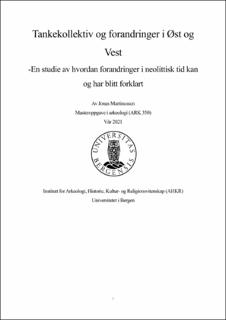Tankekollektiv og forandringer i Øst og Vest - En studie av hvordan forandringer i neolittisk tid kan og har blitt forklart
Master thesis

View/
Date
2021-06-02Metadata
Show full item recordCollections
- Master theses [207]
Abstract
During the 2100th century there came about some major changes in the Norwegian research community. An introduction of a new law gave different institutions their own separate research areas and in turn created a to different research communities in Western and Eastern Norway. A consequence of this separation can be seen in the production of scientific knowledge throughout the 2100th century and ever since. During the first half of the century there was a clear established preference in the research community where the Neolithic of Western Norway was heavily focused on. This preference in research area furthered the separation between West and East and inadvertently created to different thought collectives. These thought collectives continue to exist in our time, and they maintain the ongoing separation of West and East. To highlight this point, we can turn to the study of the introduction of agriculture in these areas and the traditional separation of the phenomenon between West and East. Through a study of the material culture, theoretic approaches, and mathematical equations we can clearly establish a connection between West and East during the Neolithic. This link however seems to be under communicated in these research collectives and studies has traditionally had an inward focus on their own areas. Another point is also how there exist a difference in theoretical preference between the two areas, something that in turn directly influences the production of knowledge and furthers a separation between them. However, through a study of the agricultural revolution using Anthony Giddens theory of structuration, it becomes possible to explain the phenomenon across both areas. Through different kinds of communication and trade networks the people in these areas interacted and exchange information concerning agricultural practices. In combination with the ritual feasting and Messenger Feasts this communication enhanced behaviors concerned with agricultural practice and a total transformation of the hunter gatherer population occurred during the late Middle Neolithic B, in both Eastern and Western Norway.